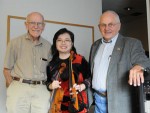Title
How many of us have not listened to a digitally recorded and mastered CD, or to synthesized sounds or MP3 files? Today, virtually all music is recorded and mastered digitally—in many cases also being digitally enhanced, such as with reverberation and equalizing. Today, we do not get our music into the world without having it go through some kind of digital process, unless it is only heard live, with no amplification or modification.
Body
All this would not have been possible if it weren’t for Max Mathews, known as “the father of computer music,” who changed our lives for good. Max was one of the first people in the world to think, “What if we used computers to make music?” back in the 1950s at AT&T Bell Labs, where he directed research in acoustics and speech synthesis, among other pioneering fields.
On October 10, Max—together with his son, Boyd Mathews, who also works at Bell Labs—visited me at Juilliard. Born in Columbus, Neb., in 1926, Max is vigorously continuing research as professor emeritus at Stanford University in California. He has been interested in a bowing technique I have been working on called subharmonics, which allows notes to be played below the open G string on the violin without changing the tuning, and he wanted to record my sounds during his trip. When faculty member Michael Czajkowski learned of Max’s visit, he suggested that we conduct our recording session in front of his Introduction to Music Technology class. The fortunate students got to see this historic figure up close at work, and were treated to an impromptu lecture on string acoustics and a fascinating high-speed video of string oscillation.
As Max explained, “I think that, by analyzing Mari’s subharmonic string vibrations, we may learn some interesting new things about how violins work. Herman Helmholtz, in the mid-19th century, was able to show that the normal vibration of a ‘good’ violin sound is made by a simple triangular waveform of string vibration. He also showed the physics of how this waveform is generated by the ‘stick-slip’ motion of the bow on the violin string, and how the pitch is properly controlled by the string length, weight, and tension. In order to get subharmonics, Mari’s bow technique must produce a very different string vibration waveform.”
In 1994, I first introduced subharmonics as a musical element during a recital at Merkin Hall. Since then, I have been continuing to improve the technique, producing several intervals other than the “pedal tone” (one octave below), which has long been known to musicians. I have also met with numerous physics and acoustics professors who wanted to study and extract the theory behind this phenomenon, which has taken me around the world from Tokyo to Massachusetts to Tromso, Norway.
Musically, I have been working extensively with composers using this technique. One, a French composer named Jean-Claude Risset, is a former director of research at IRCAM and—as another pioneer of musical acoustics in the ’60s at Bell Labs—a good friend of Max. Last year, Risset wrote a violin concerto titled Schemes, which received its premiere at Suntory Hall in Japan with the Tokyo Symphony Orchestra. I performed my own cadenza, also incorporating subharmonics. Schemes is the world’s first violin concerto using subharmonics, aside from my own concerto, which I premiered in 1999.
It is for this musical purpose—not for the sake of novelty, but to expand the possibilities for future violin repertoire—that I have been most keen on collaborating with scientists in attempts to uncover the theory of subharmonics. In the past, I have found new intervals and new techniques only empirically. If I could learn the theory behind subharmonics, it might suggest to me what else can be achieved and how.
Max Mathews is the latest scientist, and one of the world’s foremost authorities in the field, to tackle this scientific “riddle.” After all, as an enthusiastic amateur violinist himself, he has all the incentive he needs to find out.





